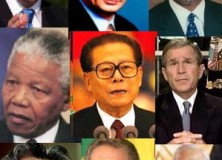Leadership Styles

What is the characteristics of a great leader? What leadership styles can we find in some of our favorite leaders? Just notice that this picture just indicates men and no woman.
As I was writing this for educational purpose, it’s valid to hear claim who I think are GREAT female leaders: Operah Winfrey, Marianne Williamson… and I have to say Nicole Daedone since she has been one of my inspiring female leaders representing what it means to embrace your sex.
There are differing opinions on how a leader should be and how they should behave in different situations. Essentially, people prefer different leadership styles.
What characterize a great leadership?
There are three features that, according to Nilsson (1993), characterizes good leadership: maturity, experience and knowledge. Maturity and experience is something that we get with age and cannot be obtained with theory. For instance, it’s common that it is seen as an advantage for women to have the experience of being a mother. Raising children, or several children, gives you leadership experience.
The issue of leadership is interesting. The ultimate existence of it might become triggering to people. As a coach I have a mission and that is to bring out the develop the leadership styles in each and everyone, to ignite that spark that takes them to the next level of where they want to be in their career, business and life. Some individuals seem to be natural leaders, while others, seem to be more comfortable in the role of follower.
For an organization to thrive there is a need for a mixture of leadership styles. In a previous blog post, I talked about my passion for transformational leaders. Clearly, today we talk about a variety different types of leadership styles: transformational, emotional, situational, authentic and many more. This new information about what it means to be a leader is something that can be characterized into the four specific forms of leadership styles, here formulated by House (1974) in his Path-Goal Theory.
Four Leadership Styles
The directive leadership style is task oriented, clarifies the goals and what has to be done in order to reach them. It explains the consequences that will happen if goals are not achieved on time or not at all. Discipline is used in order to get things done. Usually by reward and/or punishment. This style of leadership is more common in organizations like the Armed Forces.
The supportive leadership style is interested in how the employees feel. They identify various needs and tries to satisfy them. The supportive leader is trying to create a supportive and comfortable environment for employees so they will feel good at work. This style of leadership would be representative for a HR division in a larger company.
The participatory leadership style gives space for employees to take responsibility and be more involved in decision making. It is about creating a dialogue with employees in regular meetings where the possibility for feedback and communication can take place between leaders and employees. This style seems to be very common in academic organizations where nobody really stands out as a leader, rather, it’s someone responsible that brings the others in for communication and common decisions making.
The achievement oriented leadership style is focused on the performance of the employees. This might characterize sales organizations where the leaders expect the employees do as well as possible on a both an individual and organizational level. This leader believes that the work should be challenging and that employees take personal responsibility for achieving goals.
From doing leadership to being a leader
While theory teaches us the doing of leadership, today we know that there is something more that is needed. It is who you are and where you come from in your leadership, your way of being a leader, that is important. Most leaders don’t think about this. They are just doing what they need to do and not thinking about who they are and how they are communicating when they want things to happen.
In order to really create change, you need to have the capacity to transform peoples attitudes, in order to do that you need to have done the work on yourself. That is why leaders need coaching. Apply for YOUR Powerful Leadership Breakthrough Session, which has a value of $500. You find the application here.
One Response
I think that a good leader will shine and encourage others to shine!